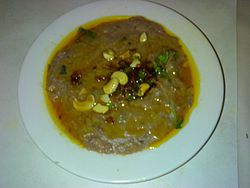Hyderabadi Biryani is a Hyderabadi biryani dish made with basmati rice and lamb meat. Popular variations use chicken instead of lamb.[1]
The blending of Mughlai and Telangana cuisines in the kitchens of the Nizam, ruler of the historic Hyderabad State, resulted in the creation of Hyderabadi Biryani
.
.
Hyderabadi haleem /ˈhaɪdərəbædɪˈhæliːm/ is a type of haleem popular in theIndian city Hyderabad. Haleem is a stew composed of meat, lentils and pounded wheat made into a thick paste. It is originally an Arabic dish and was introduced to the Hyderabad State by the Arab diaspora during the rule of the Nizams (the former rulers of Hyderabad State). Local traditional spices helped form a unique Hyderabadi haleem that became popular among the natives by the 19th-century.
Like Hyderabadi biryani, the preparation of haleem in Hyderabad has become an art form. Though Hyderabadi haleem is the traditional hors d'oeuvre at weddings, celebrations and other social occasions, it is particularly consumed in the Islamic month of Ramadan during Iftar (the evening meal that breaks the day-long fast) as it provides instant energy and is high in calories. This has made the dish synonymous with Ramadan. In recognition of its cultural significance and popularity, in 2010 Hyderabadi haleem was granted Geographical Indication status (GIS) by the Indian GIS registry office, making it the first non-vegetarian dish in India to be listed as GIS .S

Chineese Noodles are an essential ingredient and staple in Chinese cuisine. There is a great variety of Chinese noodles, which vary according to their region of production, ingredients, shape or width, and manner of preparation. They are an important part of most regional cuisines within China, as well as in Taiwan, Singapore, and otherSoutheast Asian nations with sizable overseas Chinese populations.
Chinese-style noodles have also entered the cuisines of neighboring East Asian countries such as Korea (jajangmyeon) and Japan (ramen), as well as Southeast Asian countries such as Vietnam (hủ tiếu and mì xào are both examples of Vietnamese dishes that are of Chinese origin), the Philippines, Thailand, andCambodia.
